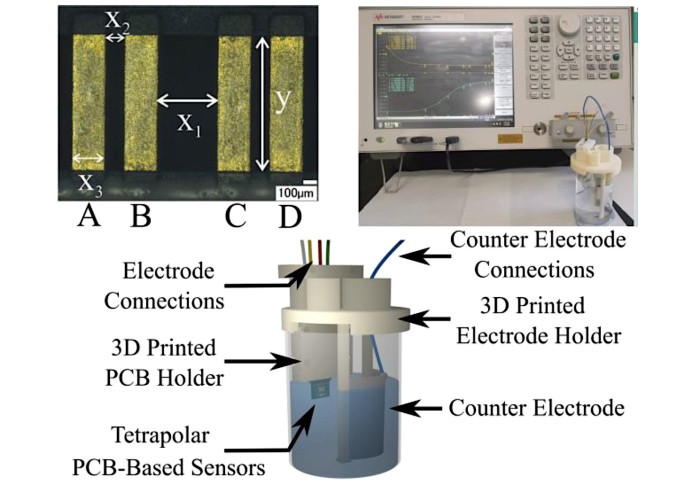A Guide of Tetrapolar Bioimpedance Sensor Measurement for Healthcare Application

Our Hamlyn researchers proposed a potential guideline for tetrapolar bioimpedance sensor measurements, aiming to assist healthcare applications.
Tetra-polar (four-point) impedance measurements are widely used in material and device characterisation, as well as sensor applications. The latter typically involves bio-impedance measurements using tetra-polar electrode systems for the characterisation of tissues, such as ischemia monitoring and cancer tissue identification.
Commercial bench-top impedance analysers represent the gold standard and provide a reference point for accurate impedance measurements. Such instruments are essential in characterising material and device impedances and sensors.
 For instance, they are necessary to experimentally verify the design of impedance sensors or to obtain the expected impedance range of a targeted load, in order to provide the design specifications for the development of custom miniature electronics.
For instance, they are necessary to experimentally verify the design of impedance sensors or to obtain the expected impedance range of a targeted load, in order to provide the design specifications for the development of custom miniature electronics.
However, many impedance analysers are incapable of performing tetra-polar impedance measurements in applications where there are large contact impedances, such as in the field of bio-impedance, as various electrodes with micron-sized features were used in the measurements.
With regard to this issue, external front-end amplifiers can help overcome this obstacle and provide high common-mode rejection ratio (CMRR) and input impedance.
A Comparison of Front-End Amplifiers for Tetra-polar Bio-impedance Measurements
Our research team at the Hamlyn Centre compared various existing discrete component-based front-end amplifier topologies with a number of new alternative topologies with respect to their frequency response and characteristics.

By means of these comparisons carried out by our research team, the result of this research can serve as a new guideline for evaluating and choosing front-end amplifiers when it comes to tetra-polar bio-impedance measurements (both with and without impedance analysers) in practical/clinical applications and material/sensor characterisation.
It is worth mentioning that among the examined amplifiers, one of the best performances is achieved with one of the proposed topologies based on a custom front-end with no external resistors (AD8066/AD8130).

When comparing measurements of resistive loads in the presence of electrode interfacial impedance models, the proposed AD8066/AD8130 front-end amplifier demonstrated the best performance at low frequencies (20 Hz), where electrode contact impedance is large, with an impedance magnitude and phase error of 3.4% and 2.8°, respectively.
Consequently, the AD8066/AD8130 front-end thus can be seen as a useful solution for the front-end amplifier of bio-impedance instrumentation systems based on discrete components.

Moreover, the practical use of the front-end with the impedance analyser is demonstrated in the characterisation of the bio-impedance sensor, in saline solutions of varying conductivities (2.5-20 mS/cm) to obtain its cell constant. It is understood that these research results are extremely useful for the design of custom instrumentation.
This research was supported by EPSRC Programme Grant “Micro-robotics for Surgery (EP/P012779/1)” (Panagiotis KassanosFlorent Seichepine , "A Comparison of Front-End Amplifiers for Tetrapolar Bioimpedance Measurements", IEEE Transactions on Instrumentation and Measurement, August 2020).
Article supporters
Article text (excluding photos or graphics) © Imperial College London.
Photos and graphics subject to third party copyright used with permission or © Imperial College London.
Reporter
Erh-Ya (Asa) Tsui
Enterprise